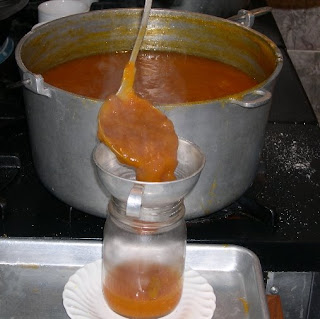
In my lifetime the farm has always had an apricot tree. When I was a girl there was a big tree close to one of my dad’s storage sheds. At least it was big by ten year old girl standards; it had a thick trunk and low, solid, spreading limbs with a green canopy of smooth oval leaves. When that tree was in its declining years my dad found a seed that had sprouted and transplanted it. That’s the tree we have today. The tree must be an heirloom variety because that first tree had to have been planted sixty or seventy years ago. That’s all I know about what kind of apricot it is other than the fact that its fruit makes the world’s best jam.

It’s not every year that our apricot tree produces fruit. Because it blooms so early in the spring more often than not its blossoms get damaged by frost and there is no fruit in June. This year we have apricots. These apricots are truly organic. No chemical fertilizers, no insecticides, nothing but Mother Nature’s own gets on the tree so the apricots are tiny—the average is about the size of a ping pong ball—and covered with freckles and blemishes, not to mention the occasional worm or insect. In appearance alone they are apricots only a mother could love but what they lack in beauty they compensate for in flavor. These little golden orange nuggets are packed with the perfect combination of sweet honey flesh that has an acidic lemony finish. This is the apricot taste I have used as a standard for every other apricot I have eaten in my life. The large lovely apricots you can find at supermarkets and even farmer’s markets are bland and flavorless in comparison.

When the apricots ripen it’s a marathon of picking, cleaning, pitting, and cooking jam. Each morning this week I took my five gallon bucket out to the apricot tree and began collecting fruit. The thermometer was hovering in the 80s and the humidity was also about 80 percent so I started on the sunny side of the tree and worked my way into the shade. The soft thud of apricots dropping from the limbs and bouncing off the grass mingled with the scolding of the mockingbird above me. As sweat rolled down my face and dripped off my nose I was careful not to step on half eaten fruit that was the local raccoons’ and ‘possums’ midnight snacks. Eventually I collected all the fruit that was ripe that morning and happily headed indoors to clean and pit my harvest. A couple of hours and a few hundred pits later I was ready to cook jam.
Apricot Jam
8 cups of pitted apricots (peaches or plums work too but remove the skin)
6 cups of sugar
2 cinnamon sticks
Prepare about 6 half pint jars, lids, and rings according to package instructions that came with the jars.

Put all the ingredients in a large pot over low heat. I use grandma’s soup pot. Stir the pot until the sugar has dissolved completely then turn up the heat to medium high. Stir constantly after mixture begins to boil. Cook and stir until mixture thickens, about 15 minutes. You can test the consistency by dropping a tablespoon of jam on a cold saucer. When the jam cools it should hold its shape, not run on the saucer. Jam should have a soft consistency, not like jelly.

Turn the heat down to low so the jam is very hot as you ladle it into the jar. Wipe the rim of the jar with a clean damp cloth, put the lid on and screw the ring on until it is just snug. You can let the jars cool at this point and keep them in the refrigerator or freezer. Because I don’t have the refrigerator space for fifty plus jars of jam I put then in my pasta pot with a stainless perforated liner and steam them for 5 to 7 minutes. It’s easier and quicker than covering them and boiling them in water the old fashion way. You can keep the sealed jars a year or more in a cool, dry, dark place.
There have been years when we had so many apricots I tried every method I could think of to preserve them. I’ve tried freezing, drying, and pickling but jam is still the hands down favorite. Apricot jam has become my secret ingredient. I use it mixed with soy sauce and garlic as a glaze for chicken, as the sweetener in my coleslaw vinaigrette, in place of some of the sugar in my French apple pie, to sweeten my morning yogurt--well you get the idea.

A couple of years ago I discovered a seed that had sprouted under this tree too. I scooped it up and planted it in a very large pot next to its momma so it would be safe from the lawn mower until it got bigger. This year it’s at least a foot tall…so the circle continues.

No comments:
Post a Comment